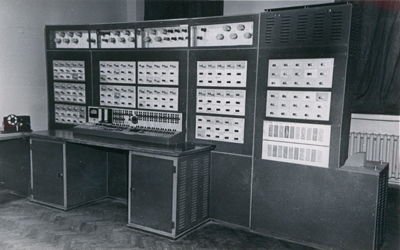|


Setun' The machine was designed by Nickolay P. Brusentsov and his colleagues at Moscow State University. Due to the low reliability of the computer elements on vacuum tubes and inaccessibility of transistors the fast elements on miniature ferrite cores and semiconductor diodes were designed. These elements work as a controlled current transformer and were an effective base for implementation of the threshold logic and its ternary version in particular. Ternary threshold logic elements as compared with the binary ones provide more speed and reliability, require less equipment and power. These were reasons to design a ternary computer.  Setun' operated on numbers composed of 18 ternary digits, or trits, giving the machine a numerical range of 387,420,489. A binary computer would need 29 bits to reach this capacity. Setun' is a sequential computer containing the fast multiplier, thanks to the speed of operation as in parallel devices is achieved. The small (3 pages of 54 words) ferrite RAM that has page exchange with the main magnetic drum memory works as a cash. Setun' has an one-address architecture with one index-register. The contents of it, in dependence of value (1, 0, -1) of address modification trit, may be added to or subtracted from the address part of instruction. The instruction set consists only of 24 instructions including performing mantissa normalization for floating-point calculation, shift, combined multiplication and addition. Three instructions are reserved but have never been used because of the lack of necessity. Essential advantages of Setun' were convenient programming and efficiency in a broad area of applications. It was the cheapest computer produced at that time in the Soviet Union and perhaps in the world. Simplicity, economy and elegance of computer architecture are the direct and practically very important consequence of the ternarity, more exactly – of representation of data and instructions by symmetrical ternary code. As a result the amount of conditional instructions is decrease twice and it is possible to use them more easily; the arithmetic operations allow free variation of the length of operands and may be executed with different lengths; the ideal rounding is achieved simply by truncation, i.e. the truncation coincides with the rounding and there is the best approximation the rounding number by rounded. The experience of creating, programming and application of Setun' unambiguously confirmed the significant preferences of ternarity. In December 1958, i.e. in two years since the beginning Setun' worked correctly at once without even debugging and began to execute the existing programs. At 1960 it was sufficient amount of programs and it was possible to present Setun' for the official testing. Such testing was passed in April 1960 very successfully. The computer demonstrated unusual for that times reliability and stability of operation in wide range of ambient temperature and supply voltage. It was found that the computer is rather simple both in manufacturing and in service, suitable for wide range of applications. Setun' was recommended for production. Unfortunately the officials of the computer production in the USSR had negative position about non-planned and unusual "fruit of university fantasy". Instead of supporting the innovation and taking a possible profit they permanently attempted to annihilate "ugly duckling". There were many orders of Setun', including ones for export, but only 10-15 computers were produced annually and none of them was exported abroad. In total there were produced 50 computers (including the specimens) between 1958 and 1965. The 30 ones were installed at universities and colleges, the rest – at research laboratories and plants. It was found that ternary computer is very favorable for seizing and application. Simplicity of programming in codes (it was decided not to make an assembler) permitted to design a few interpreters mostly in Polish inverse (postfix) notation. On such base it was possible to program the different tasks from engineering calculations and experimental results processing to manufacturing control and computer education. Some technical details are available here. |
||
|
|
|
|